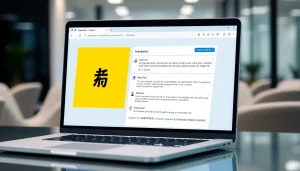Mastering the Art of Calls to Action: Why You Should Rethink ‘Click Here’
Understanding Calls to Action
In today’s digital landscape, the effectiveness of your content directly hinges on the power of your calls to action (CTAs). A well-crafted CTA can propel users to engage, while a lackluster one can allow potential conversions to slip through the cracks. One common phrase that many marketers use is “Click Here.” But is this phrase doing more harm than good? To truly understand the role of CTAs, we need to explore various facets, including their definitions, significance, and common pitfalls.
What Are Calls to Action?
Calls to action are prompts that encourage an immediate response from the audience. They guide users toward the next step in their engagement journey, whether it’s signing up for a newsletter, downloading a resource, or making a purchase. CTAs are typically succinct phrases or buttons that communicate clarity, urgency, and relevance.
Significance of Effective CTAs
The importance of effective CTAs cannot be overstated. They serve as the bridge between mere interest and active participation. Research shows that landing pages with a compelling CTA can increase conversion rates by 300% or more. Effective CTAs not only enhance user experience but also significantly impact overall business goals, such as lead generation and sales.
Common Mistakes with ‘Click Here’
Despite its widespread use, the phrase “click here” can undermine the effectiveness of your CTAs. It lacks specificity, which can confuse users about what action they are taking. More importantly, it fails to provide context, thereby diminishing the perceived value of the link it represents. As we delve deeper, we will uncover why this seemingly innocuous phrase can have far-reaching consequences for user engagement and SEO.
Why ‘Click Here’ Can Be Misleading
The Impact on User Experience
User experience (UX) is paramount in digital marketing. When visitors encounter a prompt to “click here,” they may feel unsure about what they will find on the other side of that link. This uncertainty can lead to frustration, potentially causing users to abandon the page rather than take action. Clear, descriptive CTAs allow users to understand their options and encourage them to engage with confidence.
SEO Consequences of Generic Link Text
From an SEO perspective, using generic terms like “click here” can significantly impact your content’s search engine performance. Search engines rely on link text to understand the content and context of the landing page. When a link is labeled ambiguously, it creates a situation known as “poor information scent,” making it challenging for search engines to associate the link with relevant keywords, ultimately hurting your ranking.
Accessibility Considerations
Accessibility is another critical consideration when crafting CTAs. Screen readers often read out link text, and if that text is non-descriptive, users relying on these tools may struggle to navigate the content effectively. This not only reduces usability for individuals with disabilities but also potentially alienates a significant segment of the audience. Accessible web design should prioritize clarity and relevance in link text.
Effective Alternatives to ‘Click Here’
Crafting Engaging Link Text
When replacing “click here”, consider language that is more engaging and contextually relevant. Instead of a vague prompt, opt for link text that describes the action or benefit more explicitly. For instance, “Download Your Free eBook” provides not just instruction but also an incentive for users to follow through.
Examples of Strong Calls to Action
To illustrate the power of effective CTAs, consider the following examples:
- “Subscribe to Our Newsletter” – This not only tells the user what to do but also specifies the outcome.
- “Get Your Free Trial” – Here, the value proposition is clear and enticing.
- “Join Our Community Today” – This CTA fosters a sense of belonging while urging action.
Each of these examples serves to convey value and motivation, driving users to engage rather than leaving them in doubt.
Best Practices for Link Text Optimization
To optimize link text effectively, follow these best practices:
- Use action-oriented language that clearly defines the intended action.
- Incorporate relevant keywords that can enhance SEO without compromising clarity.
- Avoid overloading with phrases like “click here” or “learn more” unless paired with descriptive context.
- Test different variations to determine which CTAs resonate most with your audience and lead to higher conversion rates.
Testing and Measuring CTA Performance
Key Metrics for CTA Effectiveness
To gauge the effectiveness of your CTAs, focus on key performance indicators (KPIs) such as click-through rates (CTRs), conversion rates, and user engagement levels. Monitoring these metrics can provide insight into how well your CTAs are performing and highlight areas for improvement.
Tools for A/B Testing Your CTAs
A/B testing is an essential strategy to evaluate the performance of different CTAs. Tools such as Google Optimize, Optimizely, and Unbounce allow marketers to test variations of their CTAs, assessing factors like color, placement, and wording. By analyzing the results, businesses can make data-driven decisions to optimize their CTAs.
Iterating Based on Data Insights
Data insights gleaned from A/B testing provide invaluable feedback about user preferences and behaviors. It’s crucial to adopt an iterative approach, continuously refining CTAs based on real-world results. Implement changes, monitor their effects, and remain agile in adapting to user needs and trends for sustained improvement.
Implementing Change Across Your Content
How to Update Existing Content
Transitioning from “click here” to more effective CTAs across your existing content is a vital task. Start by auditing all published materials and identifying places where the phrase is used. Then, replace it with optimized alternatives that offer clarity and value. This not only enhances user experience but also supports your SEO efforts.
Engaging Team Members in the Process
Transforming your CTAs is best done collaboratively. Engage team members from various departments, such as marketing, design, and copywriting, in brainstorming sessions to generate new ideas. This collaborative effort can yield diverse insights and encourage broader ownership of the content strategy.
Staying Updated with Best Practices
The digital landscape is constantly evolving, making it essential to stay abreast of the latest trends and best practices regarding CTAs. Follow industry blogs, attend webinars, and participate in professional networks to continually refine your approach to calls to action.














Post Comment